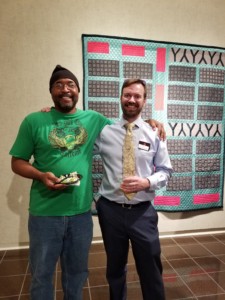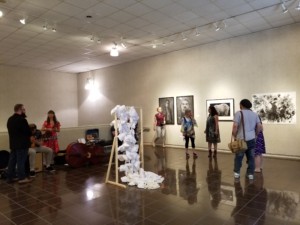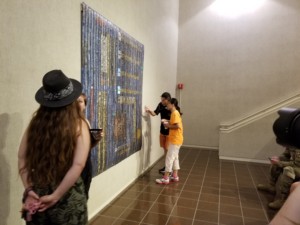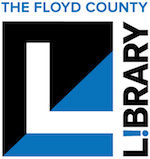This year, I was the juror for the 2018 Bluegrass Biennial which was held at the Golding-Yang Gallery at Morehead State University. The Biennial serves an important need that allows artists from across Kentucky an opportunity to share their work alongside their peers from across the state. It also provides a great opportunity for audiences in Eastern Kentucky to see what work is being produced in the Commonwealth.

Daniel Pfalzgraf (right) with Victor Sweatt (left), artist appearing at Carnegie’s AfterTaste event to be held on September 7th.
Part of my practice as curator there is to organize exhibitions with a specific audience in mind. This is something that I have focused much of my attention towards while working as the curator at the Carnegie Center for Art and History. The Carnegie isn’t just an art and history museum, but also a department of the Floyd County Library, so we serve a wide audience. In order to try to connect with as many visitors as possible, I need to curate exhibitions that provide a point of reference for people to feel comfortable approaching the contemporary art. The artwork has to provide something that is recognizable or relatable to our audience’s everyday lives that so that they have a jumping off point for them to begin their exploration.
So with that being my daily mindset as I organize exhibitions for the Carnegie, that mode of thinking often ends up being a kind of default setting when I curate or jury exhibitions for other places as well.
That is similar for many artists working today in Indiana, Kentucky, Ohio, or other flyover states in operating outside of the coastal art capitols. There is a certain personal earnestness to many of the work being created in our hometowns. These artists aren’t trying to cater to an elite class, but they are creating for the people who immediately surround them. And their work grows out of materials, experiences, and traditions found in their everyday lives. I truly feel that it’s those unique histories being shared that that makes Kentucky and Indiana-based artwork so beautiful.

Artwork in the Golding-Yang Gallery
When I started going through the jurying process for this exhibition, my initial actions were purely based on interest and quality, as best as I could tell from the digital images available. Outside of that, I didn’t have any other over-arching theme or agenda. I simply wanted to select the best work as I saw it.
At some point, however, I began thinking specifically about what the Bluegrass Biennial is, and how that informs what work to select for it. I thought about Kentucky, and traditions of art and makers throughout its history. I ended up breaking down the idea of the “Bluegrass Biennial” to the most basic idea for me to represent “Kentucky over time.” These thoughts were at the front of my mind as I was going through the galleries for the first time, looking at the work and selecting awards.
I readily admit that I am not a historian. Contemporary art is what I work with. But there has to be a kind of understanding of what came before to appreciate what is being done now. And that is what excites me most about the work in the Bluegrass Biennial. All of the work included hold some history or traditions from our past, whether it’s the materials used, a style, or technique, and then they are rearranged and presented to us in a new way today. These contemporary artworks give even the most casual viewer from Kentucky a solid point of reference for them to begin their own personal explorations.
All our actions are based upon a long history of events that occurred long before us. I feel the first step for an artist to be included in conversations about important art is when an artist is able to show that lineage linking the past to their own, new creations. Including their own stamp on history, they then can become a stepping stone for another artist in the future to learn, grow, and add to the ongoing conversations of art in Kentucky.

Gallery-goers spectating quilt by artist Arturo Sandoval
That’s not to say that I think artists should just continue creating in the same manner and style as their predecessors. To the contrary, each new generation must make their own statements to add to an ongoing conversation happening over generations. But those conversations are more fruitful if the artists are able to use the languages of the past so audiences today can better understand what is being said. Those new statements need to be created so we can continue to grow, adapt, and evolve as a community. New and contemporary isn’t always easy for some people, but I have found that if there isn’t at least a little bit of agitation pushing back, then there really isn’t any growth either. When there isn’t growth, then we are just left in a state of stagnation, frozen in time.
So that is where we are here today. With this exhibition, like so many others, honoring our past, while simultaneously agitating some folks to stimulate growth for our future.
Daniel Pfalzgraf, Curator for the Carnegie Center for Art & History

